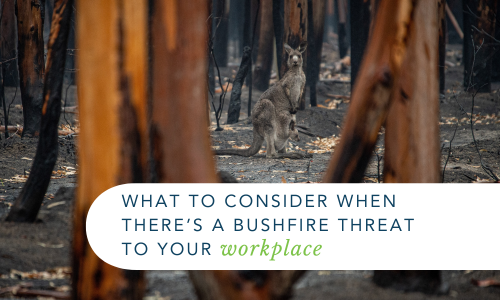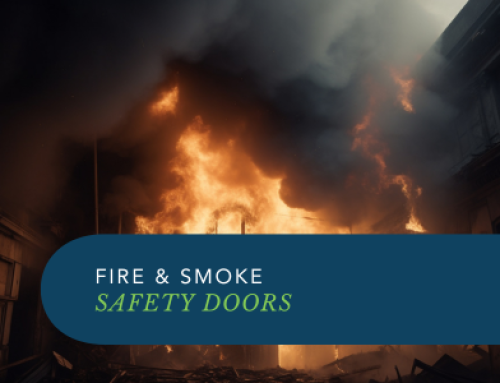Just like with homes that may be in an at-risk area, it is essential for your workplace to have emergency procedures in place to keep occupants safe when there is a bushfire threat.
If your workplace is in fire-prone land near bushland, coastal scrub or grasslands, it is vital that you and your staff know what to do in the event of a bushfire threatening your workplace.
Here are some considerations that must be taken into account when facing a bushfire threat, and when producing the Emergency Response Procedures for such an event.
When to leave the office
The decision to evacuate needs to be made at the earliest possible time to ensure the safety of all occupants.
Leaving early is the safest option and means leaving the area before a fire starts – not when you can see flames or smell smoke.
Leaving early means that you’re able to avoid panic, and lower the risk of being trapped, making the wrong choices or serious injury or death.
An essential part of any fire plan is identifying a clear trigger around when to act, including when to evacuate the premises.
There are a number of ways to assist you in making the decision to leave including;
- Monitoring the State Rural Fire Service website and/or
- Listening to your local ABC radio station for fire and weather updates
- Understanding the Bushfire Danger Ratings and
- Monitoring the Status of the Bushfire (Alert Levels).
It is crucial that all staff know what to do and understand their role and responsibilities when a bushfire emergency occurs.
It is also essential to have a Plan B in place if you are unable to leave the workplace safely.
Understanding the Bushfire Danger Ratings
The current Bushfire Danger Rating system provides a series of levels that describe the prevailing or anticipated bushfire conditions.
When a facility is located in a bushfire-prone area, it’s important for your staff to be aware of these ratings and what they represent.
The Fire Danger Ratings are:
Catastrophic
- This rating means fires will likely be uncontrollable, unpredictable and very fast moving with highly aggressive flames extending high above treetops and buildings.
- Leaving early in the day is the safest option, so do not ignore this rating if it is issued.
Extreme
- Fires will likely be uncontrollable and unpredictable. They will likely be very fast moving, with flames higher than rooftops and in treetops.
- Monitor available bushfire information sources and take advice from emergency services.
- If your workplace is in a high risk bushfire area you should consider leaving early in the day.
Severe
- Fires will likely be uncontrollable and fast moving with flames that may be higher than rooftops.
- Monitor available bushfire information sources and take advice from emergency services – follow your workplace’s procedures for staying safe.
Low – Moderate, High and Very High
- Review your emergency response procedures for bushfires and ensure all staff are aware of what to do.
- Keep alert and watch for ratings changes so that you can evacuate as early as possible, if required.
Monitoring the Status of the Bushfire – Alert Level
Where there is an actual bushfire, regularly monitor its status and the potential risk to your
facility.
Do this by the use of the mobile apps, fire service websites, call centres and ABC radio
stations in your area.
You will be able to monitor the Alert Level at the time and use this to
assist your decision making.
| Alert Level | Meaning |
|---|---|
| ADVICE | A fire has started. There is no immediate danger. Stay up to date in case the situation changes |
| WATCH AND ACT | There is a heightened level of threat. Conditions are changing and you need to start taking action to protect you and your colleagues.
Leave early when necessary. |
| EMERGENCY WARNING | An Emergency Warning is the highest level of Bush Fire Alert.
You may be in danger and need to take action immediately. Any delay now puts your life at risk. You should evacuate immediately unless you are informed it is no longer safe to do so, in which case you will need to shelter in place and liaise closely with emergency services. You may hear a siren sound on your local radio station, TV or get a message on your phone. |
What happens if you need to shelter in place?
Sheltering in place is the process of moving people to a location within the facility that is away from the effects of a bushfire.
This could be to an internal area of the building that can adequately accommodate the occupants and protect them from the effects of the bushfire, i.e. a fire stairwell, toilets, etc.
Sheltering in place should only be considered if all other options have been exhausted.
Whilst sheltered in place, maintain situational awareness by monitoring the radio, emergency services website, and smartphone applications.
Routine fire drills can save lives
The best way to prepare those in your facility is by facilitating regular fire drills, to ensure that all staff are aware of the emergency response procedures for bushfire emergencies.
Staff should also know who the Fire Wardens are for their area, and who the Chief and Deputy Wardens are for the building.
Workplace Emergency Management are the experts in safety training
Leaving your workplace safety training to the professionals ensures that your staff are being taught the most effective and up-to-date information, ensuring they are fully prepared to handle emergencies in the workplace.
Workplace Emergency Management can travel anywhere in Australia to facilitate engaging and comprehensive training that will give your staff the tools they need to keep themselves and their colleagues safe in a bushfire emergency.
Contact us today to find out more about the training and advice we offer businesses across Australia.
GET IN TOUCH
Are you ready for peace of mind that your workforce is as safe and prepared as possible?
With a dedicated team of staff ready to help you meet compliance requirements and improve the overall safety of your workplace, all you need to do is get in touch.
Request your free audit today!



